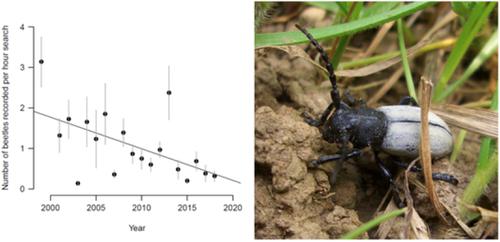当前位置:
X-MOL 学术
›
Insect Conserv. Divers.
›
论文详情
Our official English website, www.x-mol.net, welcomes your
feedback! (Note: you will need to create a separate account there.)
Factors contributing to the decline of an endangered flightless longhorn beetle: A 20‐year study
Insect Conservation and Diversity ( IF 3.2 ) Pub Date : 2020-02-11 , DOI: 10.1111/icad.12402 Bruno Baur 1 , Armin Coray 2 , Heiner Lenzin 1 , Dénes Schmera 1, 3
中文翻译:

导致濒危飞行的长角甲虫衰落的因素:一项为期20年的研究
更新日期:2020-02-11
Insect Conservation and Diversity ( IF 3.2 ) Pub Date : 2020-02-11 , DOI: 10.1111/icad.12402 Bruno Baur 1 , Armin Coray 2 , Heiner Lenzin 1 , Dénes Schmera 1, 3
Affiliation

|
- World‐wide decreases of insect abundance and diversity are of major concern because of their importance for ecosystem functioning and the stability of ecosystems. Various studies reported dramatic declines of butterflies, wild bees and beetles in agricultural areas. Yet, evidence for decreasing abundance in cryptic insect species is scarce.
- Using a transect‐count technique, we monitored the relative population size of the endangered flightless grassland longhorn beetle Iberodorcardion fuliginator in 13 dry, semi‐natural grassland sites in the border region of Switzerland, France, and Germany at yearly intervals over 20 years (1999–2018). To disentangle potential causes for changes in I. fuliginator abundance over time, we recorded quantitatively the plant communities in all sites in 2004 and 2017 and changes in other habitat characteristics.
- We found that the overall abundance of I. fuliginator individuals decreased by 90% over 20 years: at one site the population went extinct, at five sites the populations were critically decreasing, at four sites the populations were decreasing and at only three sites population size remained stable.
- Linear models revealed that the factor ‘change in plant species composition’ is the main driver for the decrease in beetle abundance. Alternative models indicated that – in addition to vegetation changes – area of suitable habitat and low heat load affected the probability of decreasing population size.
- Our study shows that gradual habitat deterioration measured as reduction in grass cover and change in plant species composition negatively affect the abundance of the highly specialised beetle I. fuliginator.
中文翻译:

导致濒危飞行的长角甲虫衰落的因素:一项为期20年的研究
- 由于昆虫的数量和多样性对生态系统功能和生态系统的稳定性很重要,因此全世界范围内的昆虫数量减少和多样性下降是主要问题。各种研究报告说,在农业地区蝴蝶,野蜂和甲虫数量急剧下降。然而,稀有昆虫物种数量减少的证据却很少。
- 我们采用横断面计数技术,以20年的时间间隔(1999年),每年在瑞士,法国和德国边界地区的13个干燥半自然草原站点中监测了濒临灭绝的不会飞的草原长角甲虫Iberodorcardion fuliginator的相对种群数量–2018)。为了弄清潜在的原因,我将发现工夫杆菌的数量随着时间的变化而变化,我们定量记录了2004年和2017年所有地点的植物群落以及其他生境特征的变化。
- 我们发现I. fuliginator个体的总体丰度在20年中下降了90%:在一个地点,人口灭绝,在五个地点,人口急剧减少,在四个地点,人口在减少,只有三个地点,人口规模保持稳定。
- 线性模型显示,“植物物种组成的变化”是导致甲虫丰度降低的主要驱动力。替代模型表明,除了植被变化以外,合适的栖息地面积和低热负荷还会影响人口减少的可能性。
- 我们的研究表明,随着草皮的减少和植物物种组成的变化,栖息地的逐渐退化对高度专业化的甲虫I. fuliginator的丰度产生负面影响。











































 京公网安备 11010802027423号
京公网安备 11010802027423号